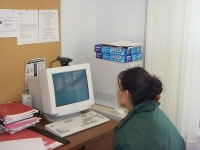Supporting Local Economic and Social Development On-line
Community leadership and a comprehensive training program has played a fundamental role in the rapid growth in the use of Information Communication Technologies (ICTs) in Fort Severn First Nation. ICTs have touched almost every individual in the remote and isolated community on the shores of Hudson Bay in Ontario’s far north. It has certainly changed the way that business is conducted by the band administration. It also has transformed the way people conduct their personal communications.
Like their urban counterparts, Fort Severn youth use email and their web pages as tools to meet other young people and to tell their stories. Several young people in the E-Center agreed that the ‘Net provides them with a powerful way to establish and maintain relationships. Youth are not the only people using the ‘Net to communicate. Parents use their email and web pages to communicate with their children attending school in the south. Elders who cannot use access the ‘Net directly press their children and grandchildren into completing various forms, make purchases and access other community services on-line. “Its more fun and sometimes cheaper to buy things on-line than to purchase them at the Northern Store,” said George Kakekaspan, a former Chief of Fort Severn.
Kakekaspan, personifies both the kind of champion that has made Fort Severn an ICT leader in the region and a community member who “walks the ITC walk” Like many community members, ICTs are tools that George uses every day as a senior manager in the Fort Severn administration office. He uses the ‘Net to book hotels and airline tickets. After work, he goes home where he does his banking and much of his shopping on-line. Since the school was closed due to mold infestation, his family moved to Thunder Bay so his children could continue with their education. He uses a video cam so that he can see his spouse and children so he can stay in touch. His children are not the only ones going to school. The ‘Net allows his spouse to continue her studies Early Childhood Education at St. Lawrence College on-line. She started the program when the family was living at Fort Severn. In spite of the need to move their family due to the school’s mold contamination, her post secondary education was not interrupted.
Access to ICTs has provided Fort Severn community members with a new tool to promote and preserve their traditional language. As part of First Nations SchoolNet, Fort Severn has been provided with training and equipment to produce digital videos that can be broadcast on the ‘Net. Using a GPS and other ICT tools, Fort Severn Elders and Youth recorded their experiences arising from two Wahaso canoe expeditions along major river systems in their tradition territories. The working language during the two trips was Cree. During these trips, Elders shared their knowledge, wisdom and historical experiences with the young people of Fort Severn. While ICTs are being used to preserve and promote the past, they are also improving community participation in the present and the future. These digital videos are popular programs on the community cable tv station.
Located near the shores of Hudson Bay, weather is a factor of everyday life that often makes it difficult for Elders and young families to attend band meetings, especially in the winter months. The E-Centre team has utilized its ICT tools to make band meetings more accessible for band members. The E-Centre facilitated the broadcast of a band meeting over the community cable television station using its digital video camera. Community members at home were encouraged to phone in their questions. “It was one of the best community meetings that we ever had. Most of the time, you have three or four people speaking at once. With the phone-in, the leadership could hear the questions and had plenty of time to answer them,” Angus Miles, the E-Centre technician said.
 |
ICTs have had a dramatic impact on other aspects of the band office operations. Most of the internal communications are conducted with email and IP “voice-over-Internet” phones. The office is virtually paperless. All forms are electronic and are protected by a firewall. Students applying for funding to attend college or university or community members seeking welfare benefits must do so on-line. “Almost half of the community members have most of the necessary skills to use computers, the Net and a variety of software, those who do not, like Elders, know someone who had those skills who can help them fill out the forms electronically,” Madeline Stoney said. “Since many of our Elders do not speak English, they would still need help to fill out paper forms so electronic forms are not much more inconvenient.” Deputy Chief Brian Crowe, a commercial pilot, says it would be hard to imagine Fort Severn without access to the ‘Net. “Almost everything we do involves ICTs. Much of the office is paperless. All of the forms and most of the paperwork is done on-line. The only paper that leaves this community are letters to the Department of Indian Affairs,” he said.
ICTs have changed the way people pass their free time. The community television cable station provides Fort Severn with many entertainment options from movies, to sports and news. It also operates a community station that provides news about local events. The station also broadcast Cal Kenny’s documentary about the Wahaso canoe expeditions that saw Elders and Youth “back to the land” to explore parts of their traditional lands.
Chief Roy Gray credits ICTs with attracting media attention to one of the major challenges facing Fort Severn. In February 2004, a critical infestation of mold was discovered in the basement of the community school. An engineering report recommended that the school be condemned in 2001. Since then, the situation has deteriorated dramatically. Acting on the recommendations of another engineering study that identified at least three types of mold dangerous to human beings, the Chief and Council ordered the closing of the school in March 2004. Chief Roy Gray, his senior staff and community members have conducted a series of meetings with INAC officials over the crisis but little progress has been made. However, a CBC TV crew arrived in Fort Severn in December 2004 to cover the school closing. David Common, the reporter, said that the CBC discovered the story on the Knet news services. “Knet News is one of web sites our research department checks out looking for story ideas” he said. Chief Gray says the ‘Net provides Fort Severn not only with a “window in the world” but a means to tell our stories and pressure decision-makers to change policies.
Ken Thomas, the Director of Education, says access to the ‘Net has had a tremendous impact on Fort Severn. He says elementary school students use computers and the Internet in the classroom. Fort Severn students have the option of remaining home for grades nine and ten through KiHS, KO’s Internet High School. “This is an important application that addresses the concerns of many parents in our community who do not want to see their children leave home at such an early age.” He says he is especially interested in seeing the ‘Net as a tool for our youth to explore their artistic abilities. “There are many artists in this community who just have not had the training to explore their talent. I want to use the ‘Net as a tool to train our youth people to use their talents creatively,” he said.
The Fort Severn E-Centre has changed dramatically since it opened. Its original mandate was to provide a point of presence and train community members in the use of computers, email and other ICT applications. “It was once the centre of all Internet activity here,” said Madeline Stoney, the E-Centre Manager at Fort Severn, but now so many people are trained and so many people have access at home that fewer and fewer people use the E-Centre.” She says people still drop in from time to time but most of the time people just email. “Without the ‘Net, we’d be pretty isolated,” she said.

